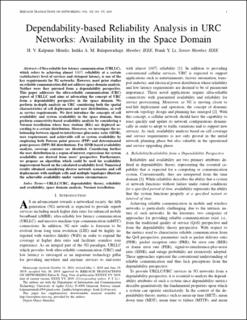| dc.contributor.author | Mendis, Handunneththi V. Kalpanie | |
| dc.contributor.author | Balapuwaduge, Indika A.M. | |
| dc.contributor.author | Li, Frank Yong | |
| dc.date.accessioned | 2020-05-18T09:17:36Z | |
| dc.date.available | 2020-05-18T09:17:36Z | |
| dc.date.created | 2019-10-17T09:06:23Z | |
| dc.date.issued | 2019 | |
| dc.identifier.citation | IEEE/ACM Transactions on Networking. 2019, 27 (5), 1915-1930. | en_US |
| dc.identifier.issn | 1063-6692 | |
| dc.identifier.uri | https://hdl.handle.net/11250/2654743 | |
| dc.description.abstract | Ultra-reliable low latency communication (URLLC), which refers to achieving almost 100% reliability at a certain (satisfactory) level of services and stringent latency, is one of the key requirements for 5G networks. However, most prior studies on reliable communication did not address space domain analysis. Neither were they pursued from a dependability perspective. This paper addresses the ultra-reliable communication (URC) aspect of URLLC and aims at advocating the concept of URC from a dependability perspective in the space domain. We perform in-depth analysis on URC considering both the spatial characteristics of cell deployment and user distributions, as well as service requirements. We first introduce the concepts of cell availability and system availability in the space domain, then perform connectivity-based availability analysis by considering a Voronoi tessellation where base stations (BSs) are deployed according to a certain distribution. Moreover, we investigate the relationship between signal-to-interference-plus-noise ratio (SINR), user requirement, and achievable cell or system availability by employing both Poisson point process (PPP) and determinantal point process (DPP) BS distributions. For SINR-based availability analysis, coverage contours are identified. Considering further the user distribution in a region of interest, expressions for system availability are derived from users’ perspective. Furthermore, we propose an algorithm which could be used for availability improvement based on the calculated availability level. Numerical results obtained considering diverse network scenarios and cell deployments with multiple cells and multiple topologies illustrate the achievable availability under various circumstances. | en_US |
| dc.language.iso | eng | en_US |
| dc.publisher | IEEE | en_US |
| dc.title | Dependability-Based Reliability Analysis in URC Networks: Availability in the Space Domain | en_US |
| dc.type | Peer reviewed | en_US |
| dc.type | Journal article | en_US |
| dc.description.version | acceptedVersion | en_US |
| dc.source.pagenumber | 1915-1930 | en_US |
| dc.source.volume | 27 | en_US |
| dc.source.journal | IEEE/ACM Transactions on Networking | en_US |
| dc.source.issue | 5 | en_US |
| dc.identifier.doi | 10.1109/TNET.2019.2934826 | |
| dc.identifier.cristin | 1737859 | |
| dc.description.localcode | © 2019 IEEE. Personal use of this material is permitted. Permission from IEEE must be obtained for all other uses, in any current or future media, including reprinting/republishing this material for advertising or promotional purposes, creating new collective works, for resale or redistribution to servers or lists, or reuse of any copyrighted component of this work in other works. | en_US |
| cristin.ispublished | true | |
| cristin.fulltext | postprint | |
| cristin.qualitycode | 2 | |
